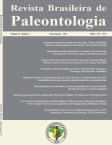LATE CENOZOIC VERTEBRATE BIOSTRATIGRAPHY AND GEOLOGICAL EVOLUTION OF THE LA CRUZ VALLEY, CORDOBA, ARGENTINA.
DOI:
https://doi.org/10.4072/21Abstract
The aim of this paper is to analyse the stratigraphic sequence, the age of
the deposits, vertebrate fossils and geological evolution of the La Cruz valley, Cordoba Province, Argentina, and how they relate to the Andean deformation of the eastern Sierras Pampeanas. In order to do so, twenty-four stratigraphic profiles were
studied throughout the valley and seven species of mammals and one amphibian were recorded. Four facies associations were identified, correlated with the Brochero, Estancia Belgrano, Pampean, Chocancharava, Río Primero and La Invernada
formations. According to this analysis the following main conclusions were reached: (i) the basal Neogene sediments of the La Cruz river represent new paleontological sites belonging to the late Pliocene (Chapadmalalan Stage/Age); (ii) the sedimentary
sequence present in the La Cruz valley began to deposit during the late Pliocene; (iii) the gathered evidence allows to verify that the sedimentary record starts with older deposits from the western part of the Sierras Pampeanas (Montehermosan Stage/
Age) extending to the eastern sector (Chapadmalalan Stage/Age). This coincides with the direction of the propagation of the Andean crustal deformation during the subduction of the low-angled Nazca tectonic plate; (iv) the registered vertebrate
fossils suggest a clear paleobiogeographic connection between the La Cruz river basin and the Pampean Region, during the late Pliocene; (v) this connection indicates, a priori, that it would have been much more evident since the Chapadmalalan
Stage/Age, instead of the Montehermosan Stage/Age; (vi) the paleobiogeographical distribution of the species Microcavia chapalmalensis, Eucelophorus chapalmalensis and Pseudotypotherium hystatum have been expanded.
Key words: paleovertebrates, biostratigraphy, Neogene, Quaternary, Argentina, Sierras Pampeanas of Córdoba.
DOI: http://dx.doi.org/10.4072/rbp.2017.2.06
Downloads
Downloads
Published
How to Cite
Issue
Section
License
This is an Open Access article distributed under the terms of the Creative Commons Attribution-NonCommercial-NoDerivatives license (http://creativecommons.org/licenses/by-nc-nd/4.0), which permits non-commercial re-use, distribution, and reproduction in any medium, provided that no alterations are made and the original article is properly cited. The written permission of Revista Brasileira de Paleontologia must be obtained before any commercial use and/or adaptation of the article.







